
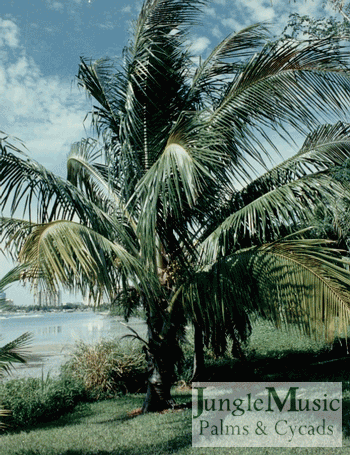
DESCRIPTION OF PALM TREES & DIFFERENT TYPES OF PALMS
by Phil Bergman
Description of Article
This article shall attempt to explain to the reader exactly what a palm tree is and how to tell the difference between the different types of palms.
Introduction
This topic might, at first, seem to be a very simple topic to explain. But, this is not really the case. This is because there are so many ways to tell someone what a palm tree is. And, there are so many different appearing palms. You could use a classical visual definition of what would one sees when he merely looks at a palm tree. Or, you could describe it in a taxonomic, scientific way. Another approach would be to define it by size or leaf appearance. Finally, one could even describe it by how it grows and what weather it tolerates. We’ve all seen the tropical and “classic” appearing Coconut Palm on a beach somewhere in the tropics. If you only used the Coconut Palm to define all palm trees, you’d be missing literally hundreds of other palms that look totally different. I’ll start below by describing the parts of a palm tree, include some taxonomy and then by giving examples of many totally different appearing palm trees.
THE HISTORY OF PALM TREES
From a fossil point of view, palm trees go back at least eighty million years ago to the Cretaceous Period during the times of the dinosaurs. Fossils of varieties of palm trees have been found from that era. As the Earth’s land masses have migrated, we even find fossils of palms in the most unexpected locations. Very old fossils of palm can even be found in the icy land masses in the Antarctic. Experts feel that perhaps palm trees were among the earliest of all flowering trees. Fossil collectors worldwide have found imprints of palm tree leaves, trunks and even flowering structures. In the height of Egyptian culture, palm trees were worshiped by many and during the Biblical days, palms were frequently described for the importance they offered to humans. In many parts of the world palms evolved into a very important part of some civilizations culture, livelihood and agriculture.
THE TAXONOMY (CLASSIFICATION) OF PALM TREES
There is a group of plants and trees known as angiosperms. An angiosperm is a flowering plant that produces seeds. These seeds are enclosed by some type of tissue. There are hundreds of thousands of types of angiosperms. Palm trees are angiosperms and do produce seeds. Among angiosperms there are two types: monocots and dicots. Palm trees are among the monocot group. They are unique in that they are a monocot with the unique characteristic that they also have woody tissues. Monocots are further divided and palm trees belong to the botanical family known as Arecaceae.Among this latter group there are many different genera of palm trees. Currently, experts believe that the number of species of palm trees is greater than three thousand with nearly two hundred genera. These include tropical species and those that live in cold areas. It includes species from essentially all continents of this planet. And, it includes small dwarf plants as well as towering species.
The three palms below are angiosperms in the family of Arecacaea. All are “Palm Trees”.

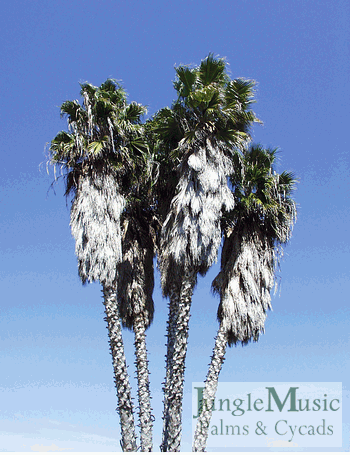

PARTS OF A PALM TREE
Trunk or Plant Stem
The trunk of a palm tree is the structure that holds the leafy vegetation above the ground. It is sometimes fleshy and at other times quite woody. But, it does not have classic bark. Size of the trunk is extremely variable, from less than a half of an inch in diameter to up to four feet in diameter. Heights can be literally nonexistent and subterranean to trunks that can be almost two hundred feet tall. True branching trunks are only seen in one genus, Hyphanae, from Africa. But, some trunks are multiple, suckering additional trunks near the base of the primary trunk. These are called multi-stemmed palms compared to a solitary stem palm. Trunk color can be glossy green or checkered brown. Some are soft and fleshy while others are hard as a rock. It is common to see “rings” on a palm trunk. These are actually types of scars left behind at the point where leaves previously attached to the trunk. Also of note is that some trunks are very smooth to touch and others are a rough surface. Some retain old leaf remnants. And, some even have prominent spines as shown. Yet others are covered with hairs and fibers. The photographs below will show you an assortment of different appearing palm trunks.
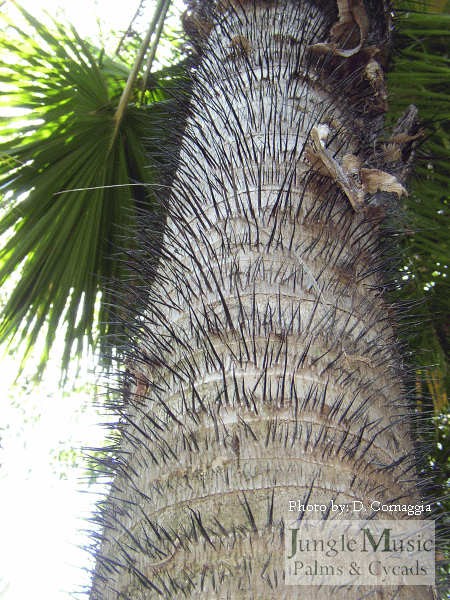
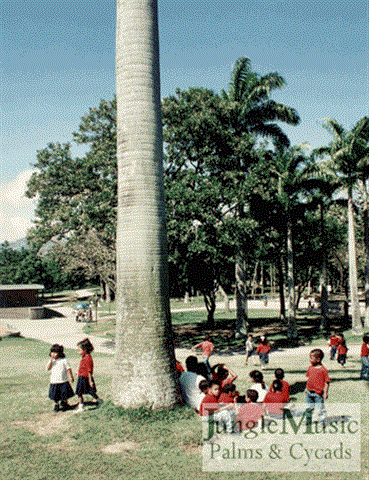
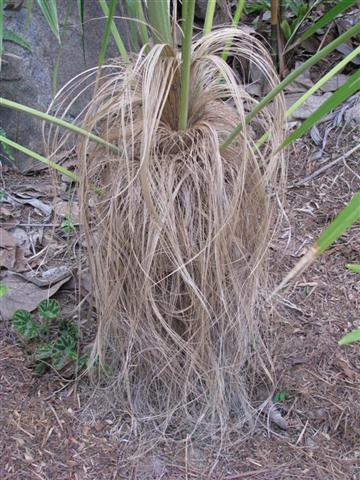
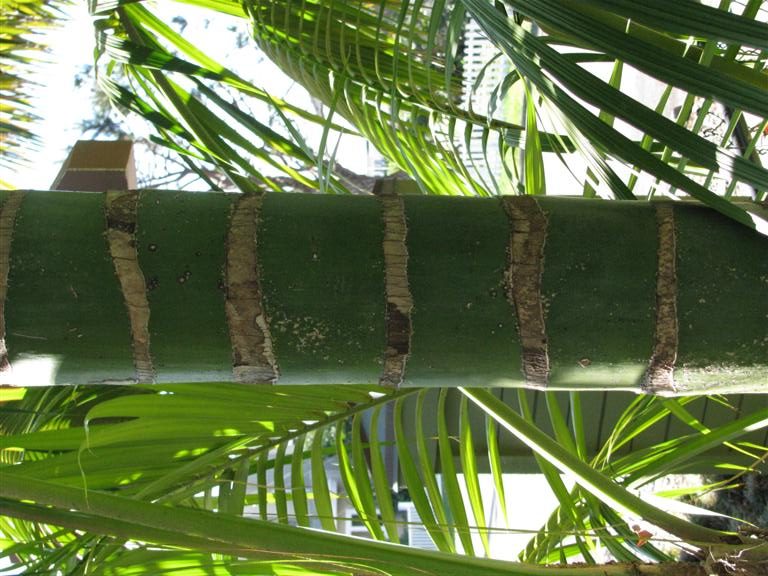
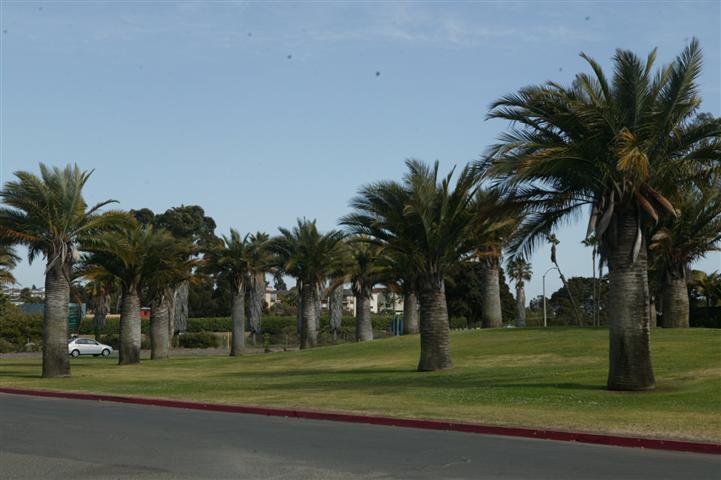
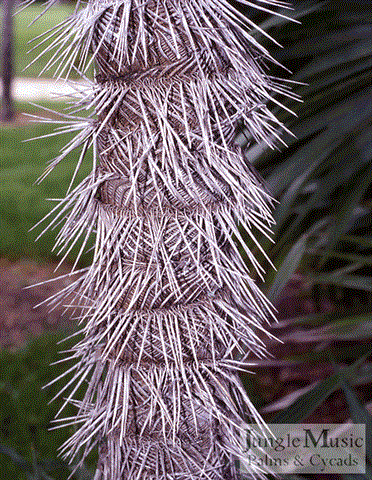
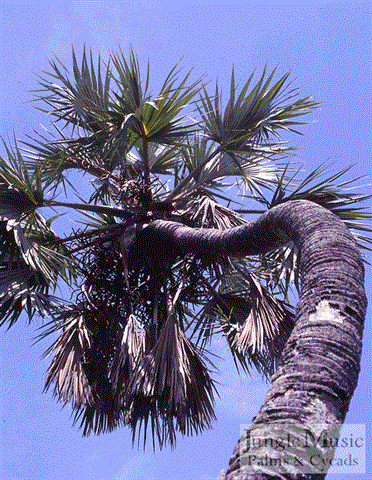
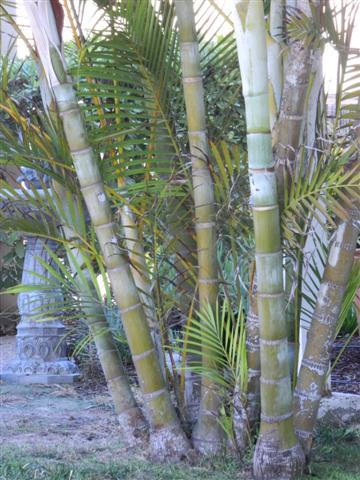
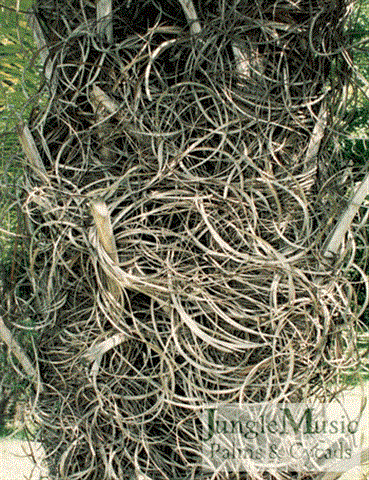
Leaf Stems
A palm tree leaf basically consists of three parts. Closest to the trunk is the leaf sheath. This is the leaf structure that holds the leaf to the trunk. Further out is the petiole or leaf stem. This is what you would grab with your hand to hold the leaf. Beyond the petiole is the actual “leaf” itself. Factually speaking one needs both the petiole and the sheath to have a complete leaf stem. Leaf stems can attach to the side of the trunk. Or, they can wrap all the way around the trunk and form what is known as a complete leaf sheath. These latter types of attachments form “crown shafts” and are are easy to spot below the crown of the leaves. Crown shafted leaves tend to be “self pruning” and fall to the ground over time without pruning. The presence of these crown shafts is quite popular among enthusiasts. They are often green in color. Leaf sheaths can hold onto the trunk for many years. When this happens old leaves above will die and hang downward next to the trunk. This forms what is called a “petticoat” of old leaves, quite commonly seen on some types of fan palms. Or, parts of the sheath can remain attached to the trunk giving it a “knobby” appearance as seen on theLivistona benthamii below. Leaf petioles can be quite short or up to ten feet long. They can be armed with spines or hooks and sometimes have razor sharp edges. So, when grabbing these petioles, it is best to wear gloves. Below are some examples of leaf stems, attached leaves and petioles.
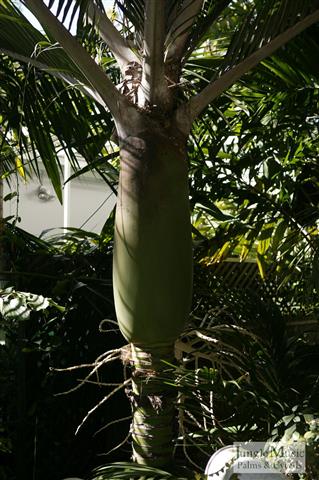
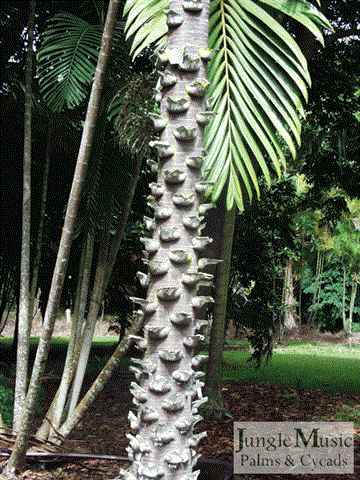



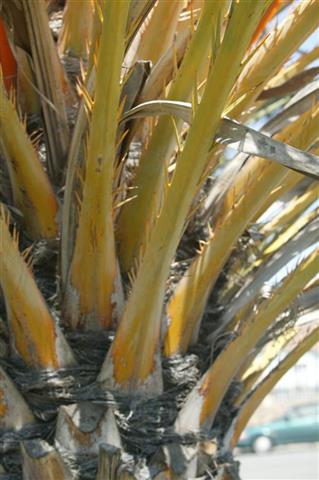

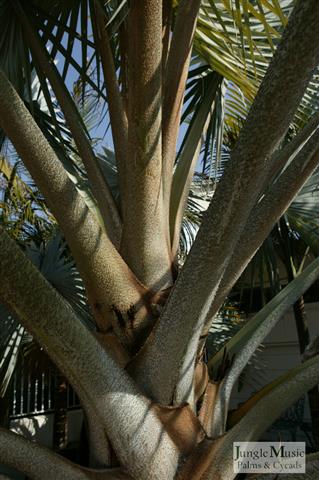
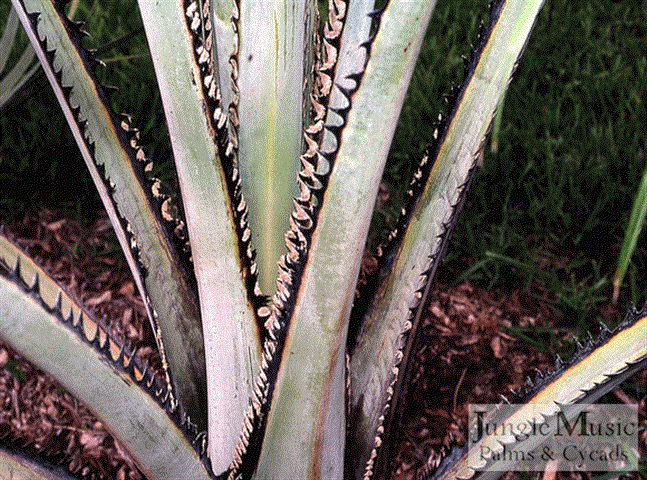
Palm Leaves
It is the terminal portion of the entire leaf structure that people think of when one says “palm leaf”. Some refer to it as the palm “frond”. This distal structure is called the segment, the blade or the palm leaf. It is attached to the petiole or leaf stem. The leaf stem is attached to the trunk. All of the leaves on a single stem plant are at the top of the trunk. Sequentially, each new leaf emerges and takes a higher position on that trunk. The size, shape and color of the leaves of various palms are quite different. This is not only in terms of size, color, texture but also in terms of their basic shape. One could say that there are four types or shapes of palm leafs:
Entire, simple or non-segmented leaf:
This type of leaf is known by the fact that it is entire, not divided and doesn’t have individual segments or leaflets. The entire simple leaf is composed of a single leaflet or blade. It is most commonly seen in species of Chamaedorea. It is the least common type of leaf. Note how, on the examples below, the leaf is not divided in any fashion.

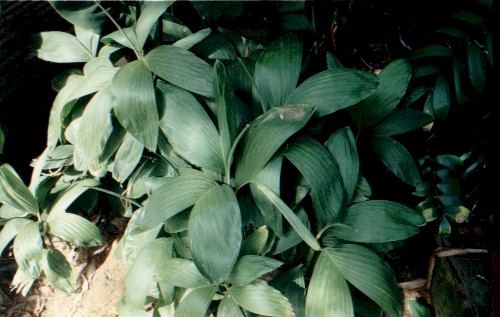

Feather or Pinnate Type of Leaf:
This is the most common leaf on palms. It is the ‘classical” leaf that people think of when they consider palm leaves. Some might call it a “feather leaf”. It is divided into segments or leaflets. These leaflets are attached to the leaf stem. The area where leaflets attach is called the leaf rachis. All the leaves compose the lamina. Each leaflet is considered a leaf segment. These leaflets are usually attached to the sides of the rachis in pairs. Sometimes these pairs are side by side or aligned. Sometimes they are offset or scattered. Sometimes they are “plumose” or attached to a different axis of the rachis. Sometimes there are groupings of leaflets with an one area between the groups of leaflets. But, all are considered pinnate or feather leaves. Below are photos of various pinnate leaves with comments about each one. Note that leaflets length and width is quite variable. And, be aware, that some palms throw newly emerging leaves that are red, pink or sometimes a bronze color.
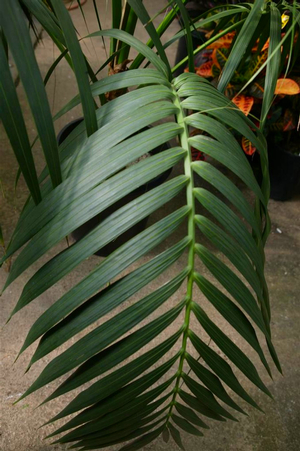
somewhat droopy and hanging downward

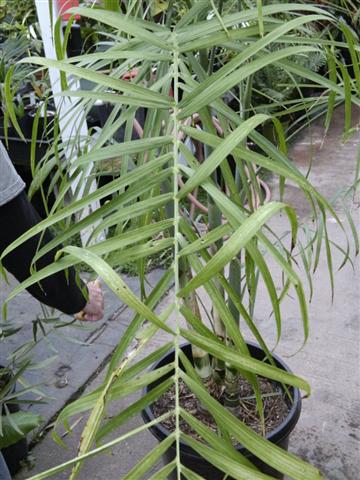
that are both grouped and multi-ranked. Thus this
species is called “plumosa” as it has a fluffy leaf.
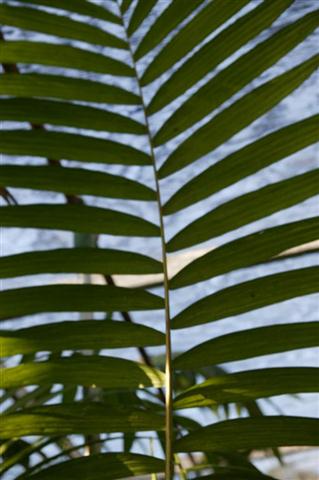
in one flat plane
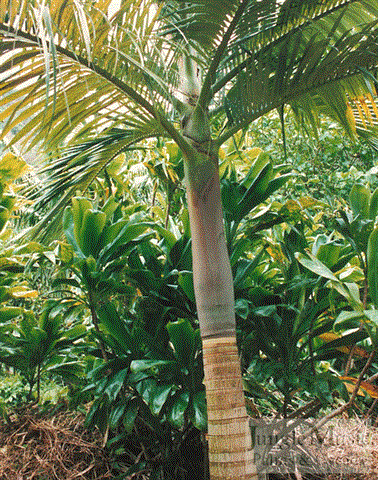
Archontophoenix purpurea.
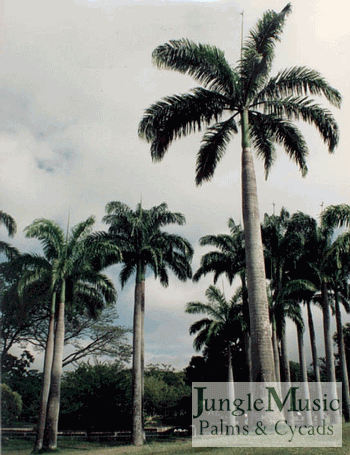
and slightly plumose leaves

plumose, multi ranked and fluffy
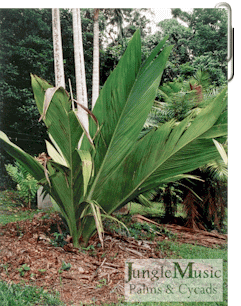
are consider pinnate leaves, especially when older
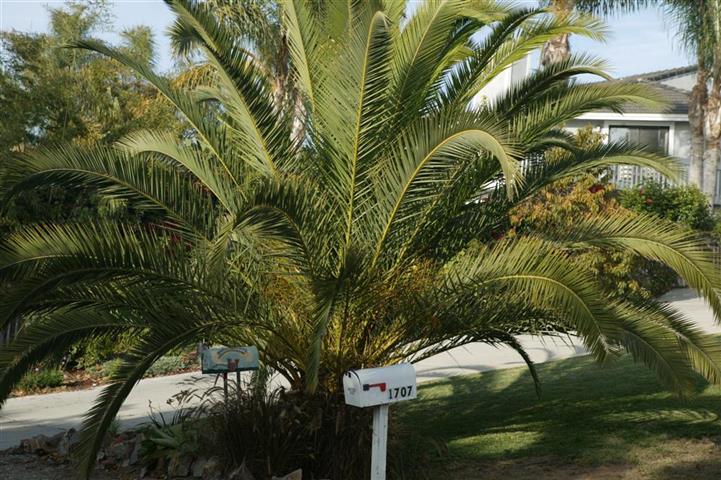
and slightly plumose leaves
Palmate or Fan Leaves:
This type of leaf is called “palmate” because it’s similar to looking at the palm of your hand. The leaf is entire in the middle and then has individual segments that radiate outward. These outwardly extending leaflets as a whole can be in a complete 360 degree circle, a 180 degree half circle or only a small part of the circle. But, all are considered fan palm leaves. Some, like Licuala grandis, make a near 360 degree circle with little divisions at the end of the individual segments. Other genera like Livistona have deeply divided segments making them pinwheel shaped. The leaf as a whole (lamina) may be wavy or completely flat. It may have different colors on the top and bottom of the same leaf. The stems may be clean or spiny. There are hundreds of variations of the fan palm leaf. Below are some examples of assorted palmate leaves with comments on each.

minimal division at the ends of the segments
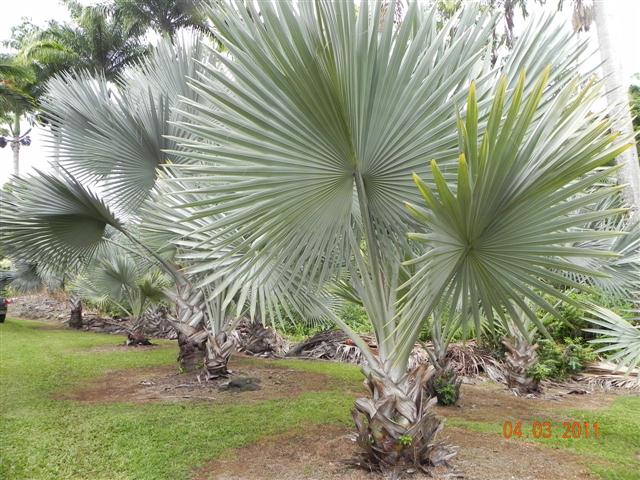

type leaves. Of course, older leaves do hang down.
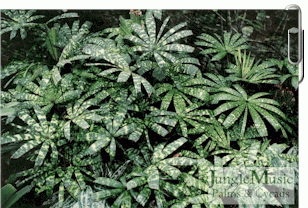
divided leaflets
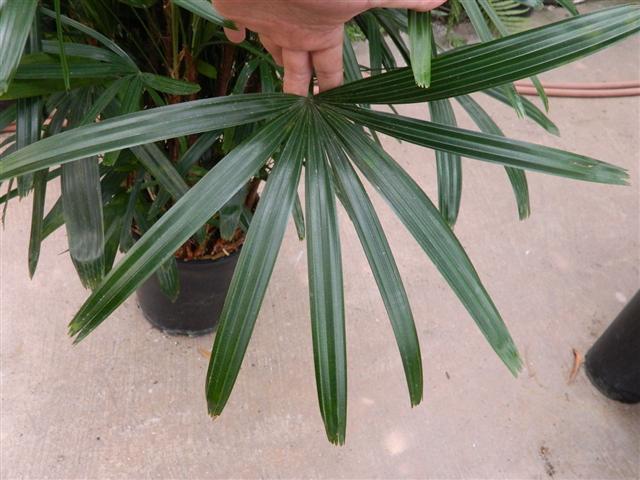
a fan palm leaf
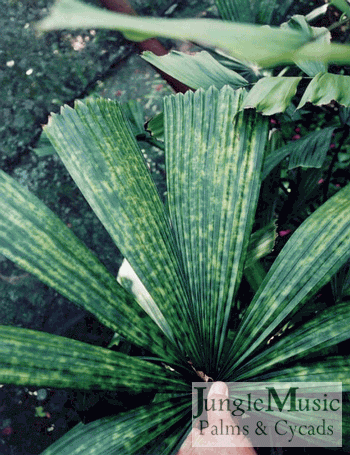
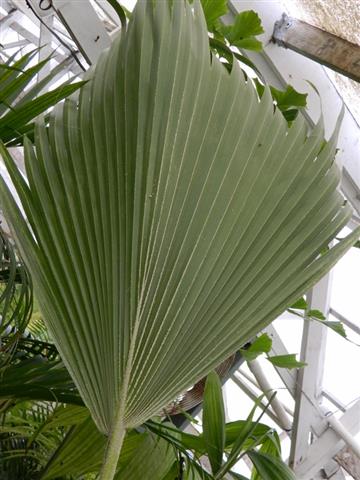
and minimal division of the terminal segments
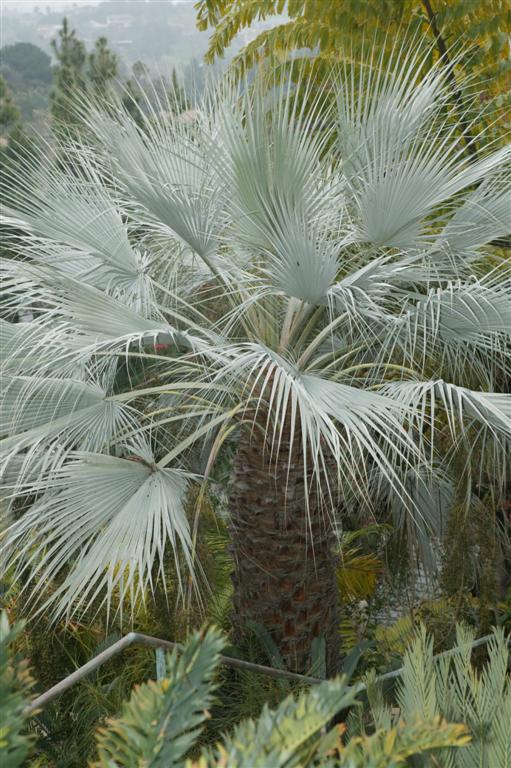
are fairly flat and moderately divided
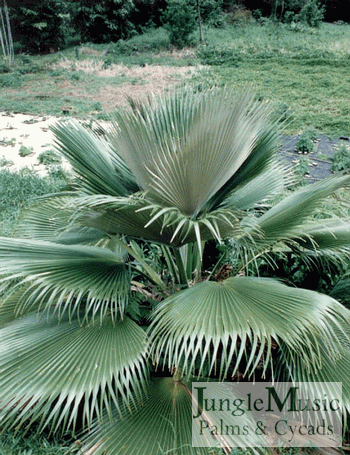
that the underside (top leaves) are silver
Costopalmate Palm Leaf:
There is another type of palm leaf that is half way between a pinnate leaf and a palmate leaf. It’s like the plant couldn’t make up its mind. With a fan palm leaf the petiole stops abruptly and the leaf segments begin. With a feather palm leaf the petiole continues on as the rachis and the leaflets are attached to this. But, on costapalmate leaves the petiole continues for a ways into the body of the leaf itself. These leaves are sort of like a hybrid of the aforementioned two types of leaves. They have both palmate and pinnate characteristics. The portion of the petiole that goes into the segments is called the rib. If it extends and juts away from the leaf it is called a hastula. The genus Sabal is most famous for having costapalmate types of leaves.
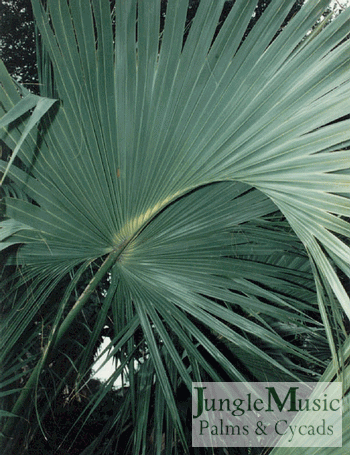
how this cost palmate leaf is an “in-betweener” of the
two types of leaves. Note how the petiole extends
into the body of the leaf.
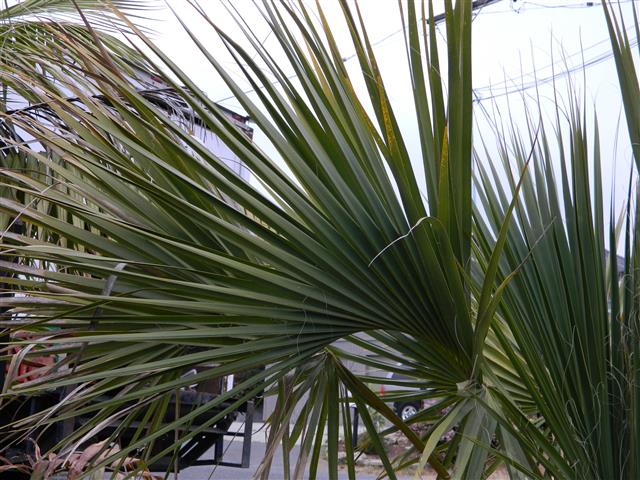
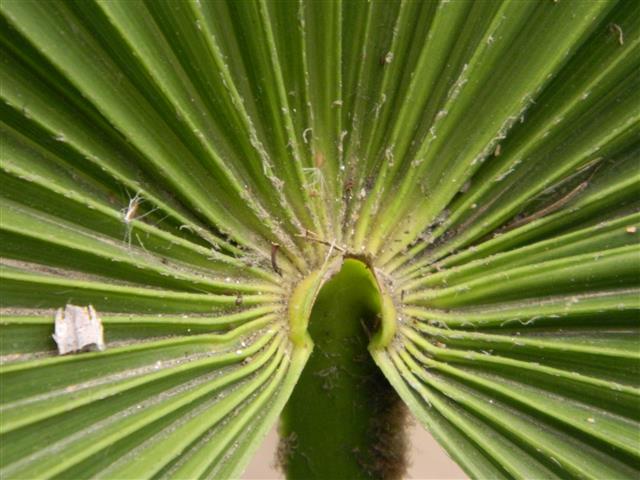
the surface of the leaf is called the “hastula”.
Flowers, Fruits and Seeds
I said above that angiosperms flower and make seeds. And, true to this, palm trees do make flowers and produce seeds. There are both male and female flowers. This is true throughout the angiosperms. But, some plants have both sexes on the same tree or plant. Palm trees where each individual plant is either a male or a female is called a dioecious species. Pollen must move from the male to the female to set viable seeds. If flowers of both sexes are on the same tree, this palm would be called monoecious. Still, insects or wind must move the pollen from the male flower to the female. So, every palm is either dioecious or monoecious. It’s beyond the purpose of this article to describe the flower characteristics of all the palm species. Note should be made that it is often said a “palm is in flower” when it is in any stage of it’s flower and seed evolution, even if the petals of the flowers are not present. So, the term “flowering” is used loosely.
Flowers emerge from the trunk, typically right below the crown of leaves or among the stems of the crown leaves. Elsewhere at this website I have an extensive article on the flowers and fruit of palm trees. Pollinated females, over time, will produce viable palm seeds. These are either eaten by animals or fall to the ground and are dispersed from there. Below are some photos of a palm flower, immature palm seeds and mature seeds on a palm. Of note, seeds produced are always covered with fruit. This fruit is typically black, brown, yellow red or orange. It should be removed before attempts are made to germinate the seeds.
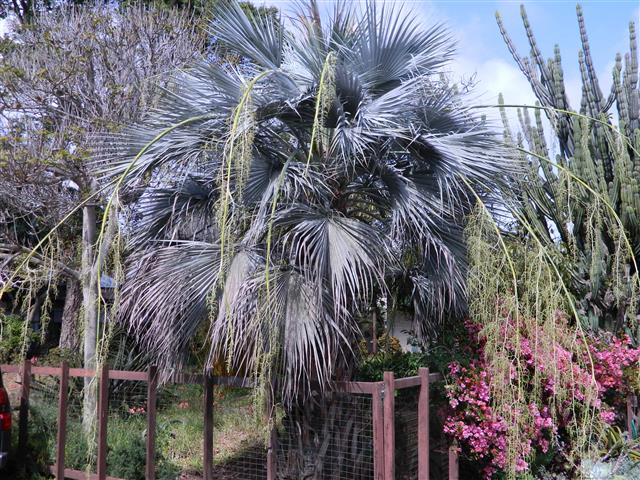

benzei with very immature, tiny seeds forming
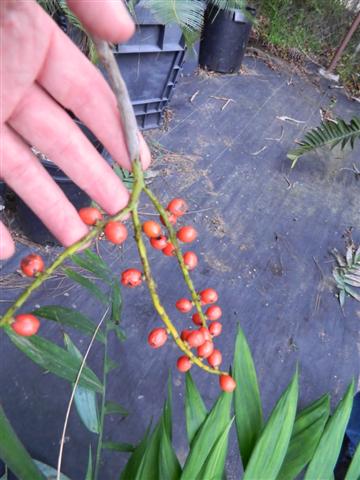
Palm Tree Roots
I am mentioning palm tree roots here they are very important to the tree but also because people always ask about them. And, their main question is “Are palm tree roots invasive”. In general, the answer to this question is “no”. There are exceptions and a massive palm tree can disturb and deck or sidewalk, but in general palm tree roots don’t lift structures or homes.
Palm roots tend to be diffuse and small in caliper. There is typically no massive tap root below the tree. Rather, they fan out with small to medium sized roots and have hair-like smaller roots that occupy the soil. It is because of this characteristic that many mature palms can be successfully dug and replanted elsewhere. There are a few specific things I’d like to mention about roots. Fist, they stabilize the tree. Remember, some palm trees are over one hundred feet tall. They also absorb water and nutrition from the soil This is their most and critical job. One must take care not to burn these roots with too aggressive fertilization.
On some species there is harm to cutting through the roots and trying to transplant it. Examples would be Bismarckia, Brahea species, Rhopalostylis and some types of Sabal. There are more to this group. As a palm grows it may send out secondary roots from the base of the trunk. These are “adventitious roots” and perform a critical job of assisting with absorption of water and nutrition and with stability. Sometimes these roots will appear above the ground, especially if the top soil is very shallow. An example of this is shown below. Other species will put out lateral roots from the trunk and these roots go to the ground, root in and add stabilize the trunk. These are called “stilt roots”. I’ll show pictures of these types of roots below as well.
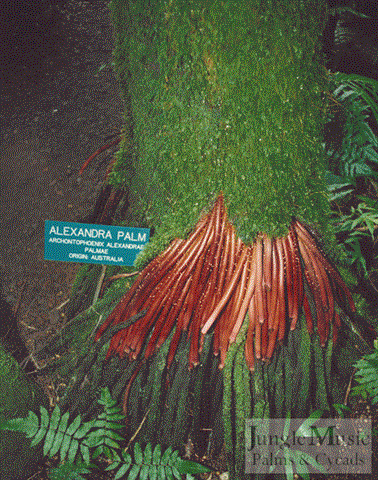
Archontophoenix alexandrae
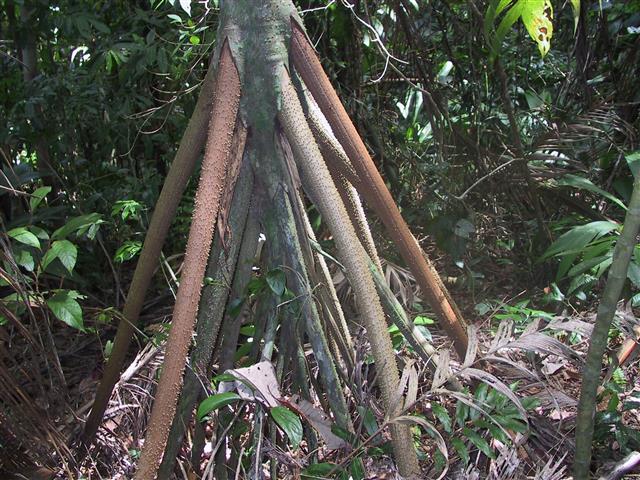
IMPORTANCE OF AND USAGES OF PALM TREES
As I am a nurseryman, I would like to say the most important usage of palm trees is in the landscape. Nothing brings back memories of the tropics more than palm trees. On an almost daily basis I hear people asking me how they can make their back yard “look like Hawaii. I’ll show a few photos below of using palms to create tropical paradises. But, there are other very important usages of palm trees. Production of food, oil and fiber from the Coconut Palm is a worldwide industry. Dates are sought out by literally billions of people, especially throughout the Middle East. The fruits of some Borassus species are also eaten in areas where they grow. Palm trunk timbers are used in construction, especially in Asia. And, trunks of Rattan Palms are critical to the furniture industry. And, this is not to forget the sugar, oil and fruit from many species which are a large industry as well. Without palms, the world would certainly be different.

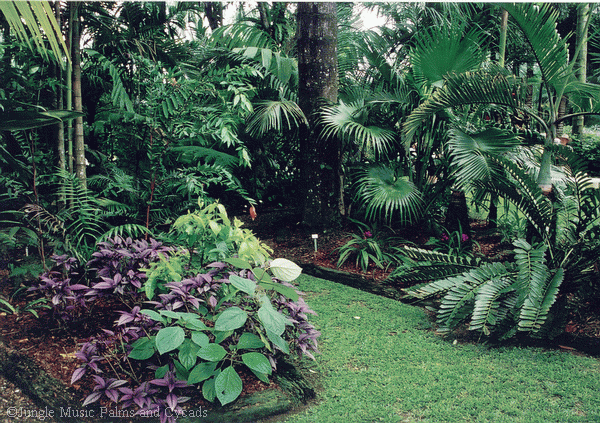
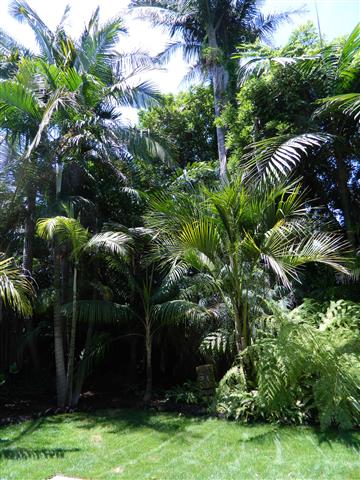
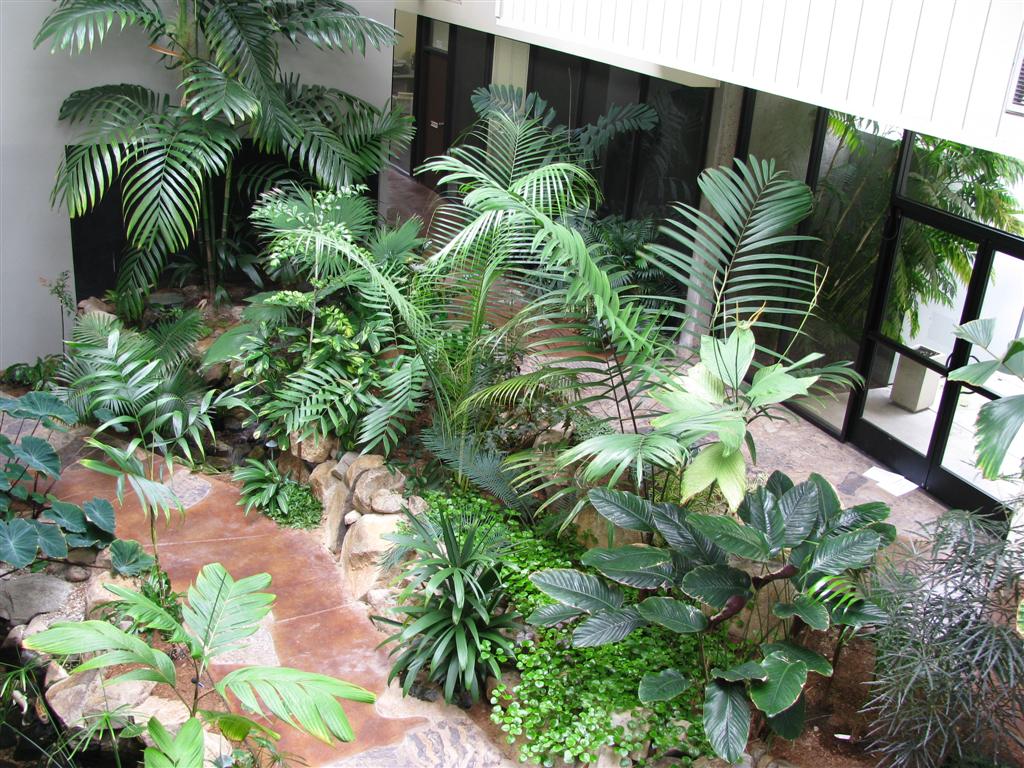
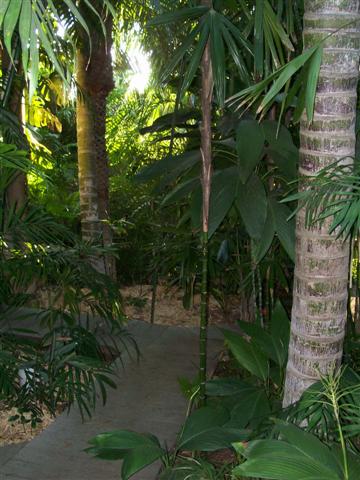
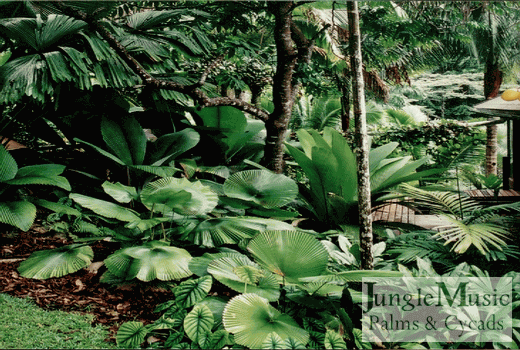
SUMMARY
Palms are a vastly diverse group of flowering trees. They are angiosperms and below this in the group of monocots. Below this they are in the palm family of Arecaceae. They have trunks, stems, leaves and flowers similar to other monocots but in no way resemble the other plants of the monocot group. Often palm trees are called “grasses” but they are not strictly speaking a type of grass. There are both male and female flowers and some species have flowers of both sexes on the same tree. The article above describes the morphological parts to a palm tree so you get a feel for their diversity. Remember, there are over 3000 species of palms. For more information on palm trees, I would refer you to other articles at this Site.
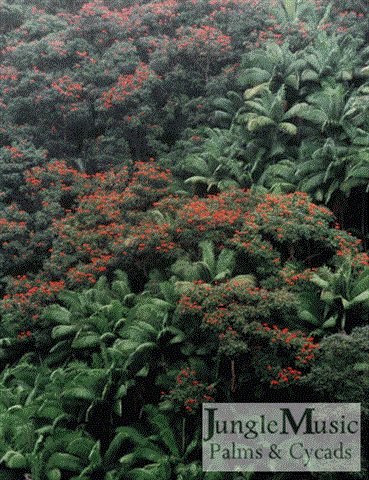
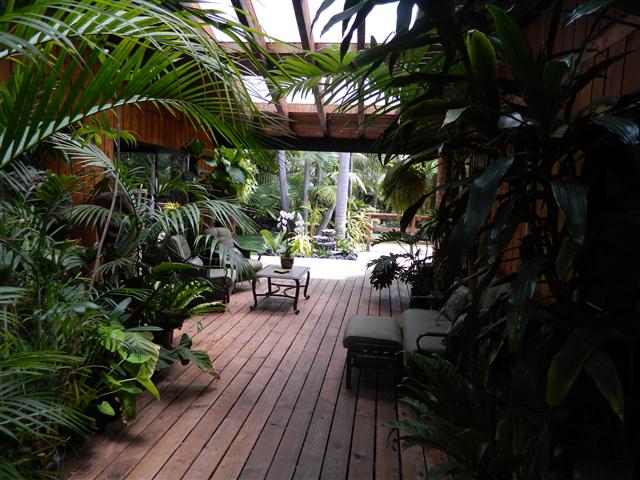
Phil Bergman
Owner
- PALM TREES, CYCADS & TROPICAL PLANT BLOG - October 1, 2020
- TRACHYCARPUS
The Windmill Palm - September 30, 2020 - FAN PALMS –
PALMS WITH CIRCULAR LEAVES - September 29, 2020












